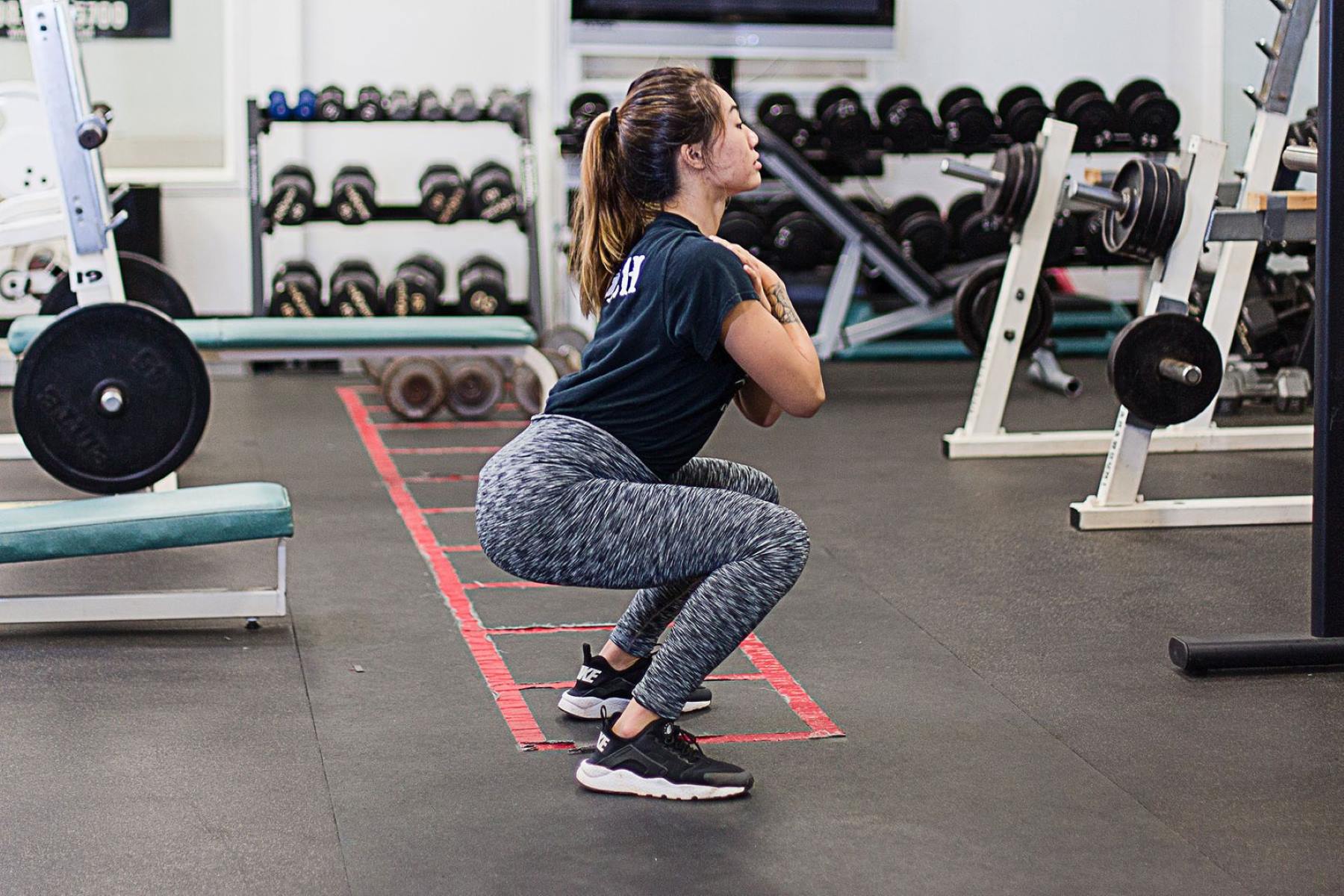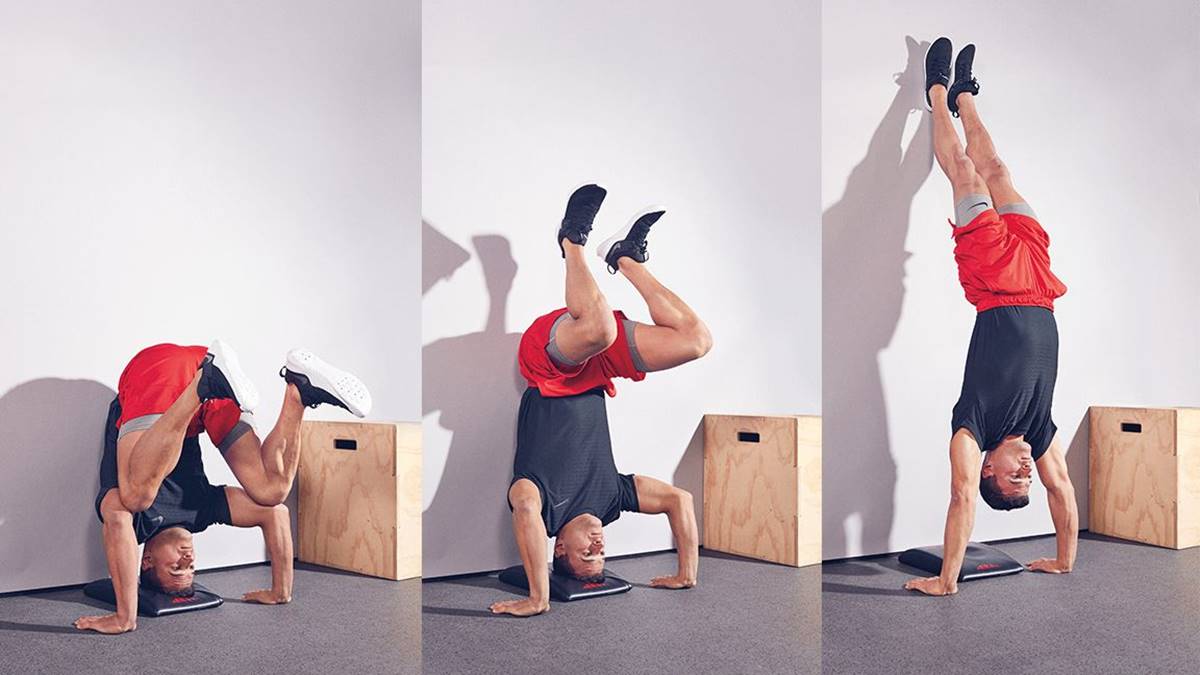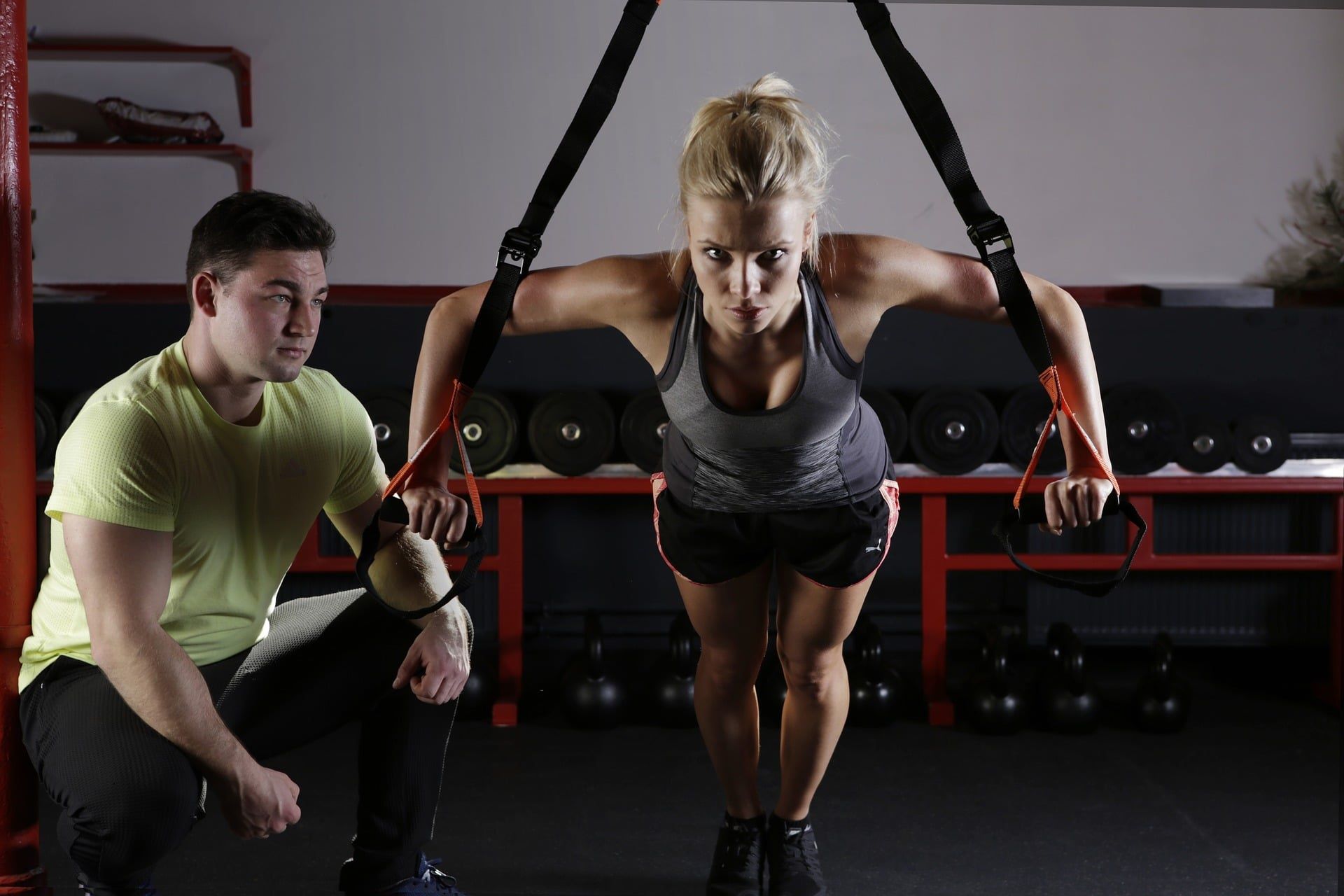Home>Misc>Featured>How Should You Lift If You Want To Increase Muscular Endurance?


Featured
How Should You Lift If You Want To Increase Muscular Endurance?
Modified: March 2, 2024
Discover the best techniques to increase muscular endurance and achieve your fitness goals with our featured workouts. Boost your performance and strength today!
Introduction
When it comes to fitness and strength training, many people focus on building muscle size and strength. While these are important goals, another crucial aspect of fitness often overlooked is muscular endurance. Muscular endurance refers to the ability of your muscles to perform repetitive contractions over an extended period of time without fatigue.
Increasing muscular endurance not only enhances your overall athletic performance but also improves your ability to perform daily activities with ease. Whether you’re an endurance athlete, a fitness enthusiast, or simply looking to improve your stamina, understanding how to lift for increased muscular endurance is essential.
Proper lifting techniques play a vital role in developing muscular endurance. By engaging specific muscle groups and performing exercises in a controlled and efficient manner, you can train your muscles to withstand fatigue and perform better in extended bouts of physical activity.
In this article, we will explore various training methods that can help you increase your muscular endurance. From circuit training to tempo training and everything in between, you’ll discover a range of techniques to incorporate into your workout routine.
Understanding Muscular Endurance
Muscular endurance is a key component of fitness that focuses on how long your muscles can sustain repeated contractions without fatigue. It is different from muscular strength, which is the maximum force your muscles can generate in a single effort. Instead, muscular endurance evaluates your muscles’ ability to perform repetitive movements over an extended period.
When you engage in activities that require muscular endurance, such as running, cycling, or performing high-repetition weightlifting exercises, your muscles rely on slow-twitch muscle fibers. These muscle fibers have a higher capacity for endurance and are responsible for sustained efforts over a prolonged period.
Improving muscular endurance offers a range of benefits. It helps delay the onset of muscle fatigue, allowing you to perform physical activities for longer durations. Additionally, it can enhance your overall performance in sports, prevent injuries, and promote efficient muscle function during everyday tasks.
To develop and maximize muscular endurance, it is essential to focus on exercises that involve high repetitions and low to moderate resistance. By gradually challenging your muscles with increased repetitions and longer durations, you can condition them to adapt and improve their endurance capabilities.
However, it is crucial to note that muscular endurance is specific to each muscle group. While you may have excellent endurance in your leg muscles for running, your upper body muscles may require additional training to improve their endurance for activities such as swimming or rowing.
Now that we have a better understanding of muscular endurance, let’s explore the importance of using proper lifting techniques to enhance endurance and prevent injury in the next section.
Importance of Proper Lifting Techniques
When it comes to increasing muscular endurance, utilizing proper lifting techniques is of utmost importance. Not only do these techniques help improve the effectiveness of your workouts, but they also minimize the risk of injury and ensure optimal muscle engagement.
1. Prevents Injury: One of the main reasons to prioritize proper lifting techniques is to prevent injuries. When you lift with incorrect form or use improper techniques, you put unnecessary stress on your muscles, joints, and connective tissues. Over time, this can lead to strains, sprains, and other musculoskeletal issues. By using proper form, you maintain optimal alignment and distribute the load evenly across your muscles, reducing the risk of injury.
2. Maximizes Muscle Engagement: Proper lifting techniques ensure that you are effectively targeting the desired muscle groups. When you use improper form, you may unintentionally recruit secondary muscles or rely more on momentum rather than muscle effort. By using proper form, you can isolate the intended muscles and ensure they are being properly engaged, which leads to more effective muscle endurance training.
3. Improves Efficiency: Correct lifting techniques improve the efficiency of your workout. When you perform exercises with proper form, you can move through the full range of motion, allowing for greater muscle activation and development. Additionally, using proper techniques reduces energy waste and allows you to perform more repetitions or exercises without tiring quickly, ultimately leading to increased muscular endurance.
4. Enhances Balance and Stability: Proper lifting techniques promote better balance and stability during exercise. By maintaining proper alignment, you have a solid base of support and can stabilize your body more effectively. This not only helps prevent falls and injuries but also allows you to perform exercises with greater control and precision, leading to improved muscular endurance.
5. Establishes Good Habits: Lastly, using proper lifting techniques establishes good habits that carry over into other areas of fitness and daily life. By prioritizing form and technique in your workouts, you develop body awareness and mindfulness of movement, which can help prevent injuries and improve overall functional fitness.
Now that we understand the importance of proper lifting techniques, let’s explore various training methods that can help you increase your muscular endurance in the next section.
Training Methods for Increased Muscular Endurance
When it comes to increasing muscular endurance, there are various training methods you can incorporate into your workout routine. These methods are designed to challenge your muscles, improve their stamina, and promote sustained performance. Let’s explore some of these training methods below:
- Circuit Training: Circuit training involves moving from one exercise to another with little to no rest in between. This training method combines cardiovascular exercise with strength training, allowing you to work multiple muscle groups while improving your aerobic fitness and muscular endurance.
- High Repetition Training: High repetition training involves performing exercises with a higher number of repetitions, typically in the range of 15 to 20 or more. This method helps build muscular endurance by challenging your muscles to sustain contractions for longer durations.
- Superset Training: Superset training involves performing two exercises back-to-back without rest. This technique allows you to target different muscle groups and increase the intensity of your workout, promoting muscular endurance.
- Tempo Training: Tempo training focuses on controlling the speed at which you perform each repetition. By emphasizing the eccentric (lowering) phase of the movement and slowing down the tempo, you challenge your muscles to work harder and improve their endurance.
- Drop Sets: Drop sets involve performing a set of an exercise until failure, then immediately reducing the weight and continuing with another set. This technique helps exhaust your muscles and push them to their endurance limits.
- Pyramid Sets: Pyramid sets involve gradually increasing the weight and decreasing the repetitions with each set. This method allows you to challenge your muscles with heavier loads while still focusing on endurance by performing higher repetition sets towards the end.
- Isometric Exercises: Isometric exercises involve static contractions where the muscle length remains unchanged. These exercises help improve muscular endurance by targeting specific muscle groups and holding the contraction for an extended period.
- Slow Eccentric Training: Slow eccentric training involves emphasizing the lowering phase of an exercise by slowing down the tempo. This method increases time under tension and works to improve muscular endurance and strength.
- Interval Training: Interval training combines bouts of high-intensity exercise with periods of rest or lower intensity activity. This method improves cardiovascular fitness and muscular endurance by challenging your muscles with intense bursts of exercise followed by active recovery.
- Active Recovery Techniques: Active recovery techniques involve incorporating low-intensity exercises or movements between sets or exercises. This promotes blood flow, aids in the removal of metabolic waste, and provides active rest to the muscles, improving their endurance capacity.
By incorporating these training methods into your workout routine and progressively challenging yourself, you can improve your muscular endurance, allowing you to perform physical activities for longer durations without fatigue.
Circuit Training
Circuit training is a popular training method for achieving increased muscular endurance. It involves performing a series of exercises one after another, with minimal rest in between. Typically, a circuit consists of 5 to 10 exercises targeting different muscle groups or movements.
The key advantage of circuit training is that it combines both cardiovascular exercise and strength training. By incorporating aerobic activities, such as jumping jacks or jogging in place, with resistance exercises like push-ups or squats, you challenge your cardiovascular system while simultaneously improving muscular endurance.
Circuit training allows you to work different muscle groups consecutively, providing ample time for one muscle group to rest while another is being engaged. This efficient use of time saves valuable minutes during your workout and keeps your heart rate elevated, resulting in increased calorie burn and improved overall fitness.
Here are some tips for effective circuit training:
- Choose a variety of exercises that target different muscle groups to ensure a well-rounded workout.
- Perform each exercise for a set amount of time or a specific number of repetitions before moving on to the next exercise.
- Keep rest periods between exercises short, aiming for 30 seconds to 1 minute. This helps maintain the cardiovascular challenge.
- Complete the circuit 2-3 times, gradually increasing the number of repetitions or duration of each exercise as your endurance improves.
- Modify the intensity of the exercises to suit your fitness level, using easier or more challenging variations as appropriate.
Some examples of exercises you can include in a circuit training session are burpees, mountain climbers, lunges, push-ups, planks, and jumping squats. Remember to perform each exercise with proper form and technique to maximize the benefits and prevent injuries.
Lastly, circuit training can be customized to suit your specific goals and preferences. Whether you’re looking to build strength, improve endurance, or lose weight, circuit training can be tailored to meet your needs.
Incorporating circuit training into your fitness routine will not only help increase your muscular endurance but also provide a dynamic and engaging workout experience. So, get ready to sweat, challenge your muscles, and elevate your endurance to new heights with circuit training!
High Repetition Training
High repetition training is a training method focused on performing exercises with a higher number of repetitions to improve muscular endurance. This training technique challenges your muscles to sustain contractions over an extended period, helping to build stamina and resistance to fatigue.
When performing high repetition training, it’s important to choose a weight or resistance level that allows you to complete the desired number of repetitions while still feeling challenged. The weight should be challenging enough to cause muscle fatigue by the end of the set, but not so heavy that it compromises your form or leads to injury.
Here are a few key benefits of incorporating high repetition training into your workout routine:
- Muscle Endurance: High repetition training targets the slow-twitch muscle fibers responsible for sustained contractions. By challenging these muscle fibers with repeated contractions, you improve their capacity to endure prolonged exertion.
- Improved Stamina: Performing exercises with higher repetitions improves cardiovascular fitness and overall stamina. As you push through each repetition, you enhance your aerobic capacity, making it easier to perform physical activities for longer durations.
- Enhanced Muscle Definition: High repetition training helps promote muscle definition and tone without adding excessive bulk. By repeatedly contracting and engaging the muscles over an extended period, you encourage muscle development while burning fat.
- Endurance for Daily Activities: Increasing muscular endurance through high repetition training has practical benefits for everyday life. You’ll find it easier to perform daily activities, such as carrying groceries, climbing stairs, or engaging in recreational activities, without experiencing premature muscle fatigue.
When incorporating high repetition training into your workout routine, keep the following tips in mind:
- Choose exercises that target specific muscle groups or movements and perform them with proper form and technique.
- Start with a weight or resistance level that allows you to complete 15-20 repetitions comfortably.
- Gradually increase the number of repetitions or sets as your endurance improves, aiming for 3 sets of 15-20 repetitions per exercise.
- Focus on controlling the movement throughout each repetition, maintaining proper form and avoiding momentum.
- Remember to breathe consistently and avoid holding your breath during the exercise.
- Allow for proper rest and recovery between sets to avoid overexertion and optimize performance.
Whether you’re using bodyweight exercises, machines, or free weights, high repetition training can be a valuable addition to your workout routine. By challenging your muscles with sustained efforts, you’ll improve your muscular endurance, increase stamina, and achieve a leaner and more defined physique.
Superset Training
Superset training is a technique that involves performing two exercises back-to-back without any rest in between. These exercises may target the same muscle group (e.g., bicep curls followed by hammer curls) or different muscle groups (e.g., bench press followed by bent-over rows).
Superset training offers several benefits, including improved muscular endurance, increased workout intensity, and time efficiency. By minimizing rest periods between exercises, you keep your heart rate elevated, promoting cardiovascular fitness while targeting specific muscle groups.
Here are some reasons why you should consider incorporating superset training into your workout routine:
- Muscle Endurance: By performing two exercises consecutively in a superset, you challenge your muscles to sustain repeated contractions for an extended period. This helps improve muscular endurance and the ability to perform repetitive movements without fatigue.
- Increased Intensity: Superset training adds an extra level of intensity to your workouts. Since you’re performing exercises without rest, your muscles experience an increased workload, resulting in improved strength and endurance.
- Efficient Use of Time: Supersets allow you to train multiple muscle groups effectively in a shorter amount of time. By alternating between exercises, you maintain a constant level of intensity, enabling you to complete your workout efficiently.
- Variety and Muscle Confusion: Superset training introduces variety into your workouts by incorporating different exercises for the same muscle group or targeting opposing muscle groups. This helps prevent plateaus and keeps your muscles guessing, promoting continued progress.
- Increased Calorie Burn: Because superset training keeps your heart rate elevated, it promotes calorie expenditure and fat burning. This can be beneficial for those looking to lose weight or maintain a healthy body composition.
When incorporating superset training into your workout routine, keep the following tips in mind:
- Select exercises that target specific muscle groups or movements.
- Choose exercises with similar equipment or setups to minimize transition time.
- Perform 8-12 repetitions of each exercise with proper form and technique.
- Rest for a short period (15-30 seconds) between supersets, if needed.
- Focus on maintaining the correct range of motion and engaging the targeted muscles throughout each exercise.
- Gradually increase the number of supersets or the resistance used as your endurance improves.
Superset training can be customized to suit your fitness goals and preferences. Whether your aim is to build strength, improve muscular endurance, or increase overall fitness, incorporating supersets into your routine can help you achieve your desired results.
Tempo Training
Tempo training is a method that focuses on controlling the speed or tempo at which you perform each repetition of an exercise. By deliberately manipulating the timing of both the concentric (lifting) and eccentric (lowering) phases of the movement, you can effectively challenge your muscles and improve their endurance.
When it comes to tempo training, the numbers represent the time duration of each phase of the exercise. The most common tempo notation follows a 4-digit format, such as 2-0-2-0. Let’s break down what each number represents:
- Eccentric (lowering) phase: The first number denotes the amount of time it takes to lower the weight or resistance. For example, in a tempo of 2-0-2-0, you would lower the weight over a count of 2 seconds.
- Isometric (hold) phase: The second number represents the duration of the pause or hold at the bottom of the movement. In a tempo of 2-0-2-0, there is no pause, so it is noted as 0 seconds.
- Concentric (lifting) phase: The third number indicates the time it takes to lift the weight or resistance. In our example, the weight would be lifted over another 2-second count.
- Isometric (hold) phase: The final number refers to the pause or hold at the top of the movement. In a tempo of 2-0-2-0, there is no pause, so it is noted as 0 seconds.
Tempo training provides several benefits for muscular endurance:
- Increased Time Under Tension: Performing exercises with a controlled tempo increases the overall time under tension, leading to greater muscle activation and endurance.
- Improved Mind-Muscle Connection: By focusing on the tempo of each repetition, you develop a stronger mind-muscle connection, enhancing your ability to recruit and engage the targeted muscles effectively.
- Enhanced Muscle Control: Tempo training promotes better muscle control throughout the entire range of motion, minimizing the reliance on momentum and emphasizing muscle effort.
- Greater Muscle Fiber Recruitment: The deliberate and controlled nature of tempo training stimulates both slow-twitch and fast-twitch muscle fibers, allowing for comprehensive muscular development and endurance.
When incorporating tempo training into your workouts, keep the following guidelines in mind:
- Select a tempo that suits your fitness level and goals. Beginners might start with a slower tempo, such as 3-1-2-0, while more advanced individuals can use a faster tempo, like 2-0-1-0.
- Maintain proper form and technique throughout each repetition, paying particular attention to maintaining control during the eccentric phase.
- Start with lower weights or resistance and gradually increase as you become more comfortable and proficient with the tempo.
- Consistency is key in tempo training. Aim to perform each repetition with the same timing and control to maximize its effectiveness.
By incorporating tempo training into your workout routine, you can challenge your muscles in a new way, improve their endurance, and see noticeable progress in your muscular strength and control.
Drop Sets
Drop sets are a training technique that involves performing a set of an exercise to failure, then immediately reducing the weight or resistance and continuing the set. This technique maximizes muscular endurance and promotes muscle hypertrophy by pushing your muscles to their limits and inducing metabolic stress.
The primary goal of drop sets is to extend the duration of the set and keep the muscles under tension for an extended period. By performing additional repetitions with a lighter load after reaching failure, you challenge your muscles to continue working even when fatigued.
Here are some reasons why drop sets can be an effective method for increasing muscular endurance:
- Progressive Overload: Drop sets allow you to progressively overload your muscles by increasing the volume of work performed within a single set. This can lead to better muscular endurance as your muscles adapt and grow stronger.
- Break Through Plateaus: Drop sets can be an effective technique for breaking through plateaus and pushing your muscles beyond their previous limits. By continuing the set with a lighter weight, you extend the time under tension and challenge your muscles in a different way.
- Increased Time Under Tension: Drop sets prolong the duration of the set, leading to increased time under tension. This can improve muscle fiber recruitment, metabolic stress, and overall endurance.
- Mental Endurance: Drop sets also test your mental endurance by pushing you to continue working when your muscles are fatigued. This mental fortitude can carry over to other areas of your fitness journey and everyday life.
When incorporating drop sets into your workout routine, consider the following tips:
- Select an initial weight or resistance that allows you to perform around 8-12 repetitions with good form.
- Perform the exercise to failure, reaching the point where you can no longer complete another repetition with proper form.
- Immediately reduce the weight or resistance by 20-30% and continue the set for as many additional repetitions as possible.
- You can perform multiple drop sets within a single exercise, gradually decreasing the weight or resistance.
- Focus on maintaining proper form and technique throughout the set, even as you approach failure.
- Allow for adequate rest and recovery between sets to ensure proper muscle recuperation.
Drop sets can be incorporated into various exercises, including resistance training exercises using free weights, machines, or bodyweight. Experiment with different variations and find what works best for your specific goals and preferences.
By incorporating drop sets into your training routine, you can challenge your muscles to new levels, increase muscular endurance, and experience gains in both strength and stamina. Remember to listen to your body and adjust the intensity and weights as needed to ensure safe and effective training.
Pyramid Sets
Pyramid sets are a popular training method for increasing muscular endurance and strength. This technique involves gradually increasing the weight or resistance while decreasing the number of repetitions with each set. Pyramid sets allow your muscles to experience a progressive overload, challenging them at different intensity levels throughout the workout.
Here are some key benefits of incorporating pyramid sets into your workout routine:
- Progressive Overload: Pyramid sets provide a structured approach to progressively overload your muscles. By increasing the weight and decreasing the repetitions with each set, you challenge your muscles to adapt and grow stronger over time.
- Improved Muscular Endurance: Pyramid sets help improve muscular endurance by exposing your muscles to various intensities within a single workout. Higher-repetition sets at the beginning of the pyramid build endurance, while heavier sets towards the end focus on strength development.
- Increased Mind-Muscle Connection: Pyramid sets foster a strong mind-muscle connection as you focus on the subtle changes in weight and repetition. This awareness allows you to better engage and control the targeted muscles during each exercise.
- Efficient Time Management: Pyramid sets maximize your workout efficiency by targeting both high repetitions and heavy loads in a single session. This saves time and allows you to work on multiple aspects of strength and endurance simultaneously.
- Muscle Adaptation: The variation in intensity throughout the pyramid sets challenges your muscles in different ways. This can help prevent plateaus and stimulate muscle growth, leading to improved overall performance and endurance.
Here’s an example of how to structure a pyramid set:
- Set 1: Choose a weight that allows you to perform 12-15 repetitions with good form.
- Set 2: Increase the weight and perform 8-10 repetitions.
- Set 3: Further increase the weight and perform 6-8 repetitions.
- Set 4: Increase the weight again and perform 4-6 repetitions.
- Set 5: Depending on your fitness level, you can choose to finish with a final heavy set of 1-3 repetitions to challenge your muscles further.
It’s important to note that the specific number of sets and repetitions may vary based on your goals, fitness level, and preferences. Customize the pyramid set to suit your needs and gradually progress as your muscular endurance improves.
Remember to warm up adequately and use proper form and technique throughout each set. Maintain control, focus on the targeted muscle groups, and avoid sacrificing form for heavy weights.
By incorporating pyramid sets into your workout routine, you can experience the benefits of both endurance and strength training. This structured approach challenges your muscles in various ways, leading to improved muscular endurance, strength, and overall fitness.
Isometric Exercises
Isometric exercises are a unique training method that involves contracting your muscles without any visible movement in the joints. These stationary contractions provide a challenging way to improve muscular endurance and strength. Instead of relying on dynamic movements, isometric exercises focus on holding a static position to engage and challenge specific muscle groups.
Here are some reasons why you should consider incorporating isometric exercises into your workout routine:
- Targeted Muscle Engagement: Isometric exercises allow for isolated muscle engagement, targeting specific muscle groups and holding them under tension for an extended period. This concentrated effort helps improve muscular endurance in the targeted areas.
- Joint Stability and Strength: Isometric exercises not only strengthen the muscles but also improve joint stability by stimulating the surrounding connective tissues. This can help reduce the risk of injury and improve overall joint health.
- Time Under Tension: Isometric contractions create a static muscle contraction, leading to a prolonged time under tension. This sustained effort challenges the muscles to maintain the contraction for an extended period, improving endurance capacity.
- Improved Mind-Muscle Connection: Isometric exercises require a strong mind-muscle connection as you focus on maintaining a stationary position. This heightened connection helps you better engage and control the targeted muscles during the exercise.
- Convenient and Accessible: Isometric exercises can be performed anywhere, as they require little to no equipment. This makes them a convenient choice for those who prefer at-home workouts or have limited access to gym facilities.
Here are a few examples of isometric exercises:
- Plank: Assume a push-up position, resting on your forearms and toes. Hold this position, keeping your body in a straight line, engaging your core muscles and maintaining the contraction for a specific duration.
- Wall Sit: Stand with your back against a wall and lower your body into a seated position, as if sitting in an imaginary chair. Hold this position, with your thighs parallel to the ground, engaging your quadriceps and maintaining the contraction for a specific duration.
- Side Plank: Lie on one side with your elbow under your shoulder and your feet stacked on top of each other. Lift your hips off the ground, creating a straight line from your head to your heels. Engage your obliques and hold this position for a specific duration, then switch to the other side.
- Static Lunge: Assume a lunge position with your front knee bent at a 90-degree angle and your back knee hovering just above the ground. Hold this position, engaging your quads, glutes, and core muscles, and maintain the contraction for a specific duration. Repeat on the other side.
When performing isometric exercises, focus on maintaining proper form and technique throughout the entire duration. Breathe deeply and evenly, and avoid holding your breath. Gradually increase the duration of each hold or the number of repetitions as your endurance improves.
Isometric exercises can be used as a standalone workout or incorporated into your existing routine. By including these static contractions, you can effectively improve your muscular endurance, strengthen your muscles and joints, and enhance your overall fitness and performance.
Slow Eccentric Training
Slow eccentric training is a training method that emphasizes the lowering or eccentric phase of an exercise. Instead of focusing solely on the concentric or lifting phase, slow eccentric training involves controlled and deliberate lowering of the weight or resistance. This technique places greater stress on the muscles during the lengthening phase and is an effective way to improve muscular endurance.
Here are some reasons why slow eccentric training should be incorporated into your workout routine:
- Muscle Fiber Recruitment: Slow eccentric training recruits more muscle fibers compared to regular lifting. By extending the time under tension during the eccentric phase, you challenge and stimulate both slow-twitch and fast-twitch muscle fibers, leading to improved muscular endurance and strength.
- Increased Time Under Tension: Slow eccentric training prolongs the duration of each repetition, increasing the time under tension for the muscles. This extended stress promotes greater muscle adaptation, endurance, and development.
- Fatigue Resistance: By focusing on the eccentric phase, you train your muscles to better withstand fatigue. This is especially beneficial for activities that involve eccentric muscle contractions, such as running downhill or lowering weights during strength training exercises.
- Muscle Control and Stability: Slow eccentric training improves muscle control and stability, enhancing joint stability and reducing the risk of injury. It allows you to maintain better form and technique, promoting proper alignment and minimizing the reliance on momentum.
- Strength Gains: Slow eccentric training not only improves muscular endurance but can also lead to gains in overall muscular strength. The increased stress on the muscles during the eccentric phase stimulates muscle growth and adaptation.
Here are some examples of how to incorporate slow eccentric training into your workouts:
- Barbell Squats: Take 4-6 seconds to lower yourself into the squat position, focusing on controlling the descent. Then, explosively lift the weight back to the starting position.
- Dumbbell Bicep Curls: Lower the weights slowly and with control, taking 3-4 seconds to lower them to the starting position. Then, curl the weights back up using a more explosive movement.
- Push-ups: Lower your body slowly, taking 3-4 seconds to descend towards the ground. Once your chest reaches just above the floor, push back up with a more explosive movement.
- Tricep Dips: Lower your body slowly, taking 3-4 seconds to lower yourself towards the ground. Once your elbows reach a 90-degree angle, push back up using a more explosive movement.
When incorporating slow eccentric training, focus on maintaining proper form and technique throughout the entire movement. Keep your core engaged and control the weight or resistance as you lower it. Gradually increase the duration of each eccentric phase or the weight used as your endurance improves.
Slow eccentric training can be utilized in various exercises and tailored to your specific goals and preferences. By incorporating this method into your workout routine, you can effectively improve muscular endurance, enhance muscle control and stability, and achieve greater overall strength.
Interval Training
Interval training is a highly effective method for improving muscular endurance and cardiovascular fitness. It involves alternating between periods of intense activity and active recovery. By pushing your limits during the high-intensity intervals and allowing for brief recovery periods, interval training challenges your muscles to sustain intense efforts over time.
Here are some reasons why interval training should be incorporated into your workout routine:
- Increased Cardiovascular Fitness: Interval training helps improve your cardiovascular system by pushing your heart rate to higher levels during the intense intervals. This leads to enhanced oxygen delivery to the muscles and improved overall endurance.
- Improved Anaerobic Capacity: The intense bursts of activity during interval training target your fast-twitch muscle fibers, which are responsible for short, explosive bursts of power. By training these fibers, you increase your anaerobic capacity and improve your ability to sustain high-intensity efforts.
- Enhanced Calorie Burn: Interval training promotes a significant calorie burn during and after the workout. The intense periods of activity boost your metabolism, allowing you to continue burning calories even after you’ve finished exercising.
- Time Efficiency: Interval training is a time-efficient way to improve muscular endurance, as it combines both cardiovascular exercise and strength training in one session. By alternating between high-intensity efforts and recovery periods, you can achieve desired fitness outcomes in less time.
- Mental Toughness: Interval training pushes you out of your comfort zone, requiring mental focus and perseverance. This mental fortitude cultivated during intervals can have far-reaching benefits in other areas of your life.
When incorporating interval training into your workout routine, consider the following tips:
- Select Appropriate Work-to-Rest Ratios: Determine the appropriate work-to-rest ratio based on your fitness level and goals. For example, a common ratio is 1:1, where the high-intensity efforts are matched with equal periods of active recovery.
- Choose Suitable Exercises: Select exercises that allow you to perform intense efforts and safely recover during the rest periods. This can include cardiovascular activities like sprints, cycling, or rowing, combined with bodyweight or weighted exercises.
- Gradually Increase Intensity: Start with shorter intervals and gradually increase the duration or intensity as your endurance improves. Strive to challenge yourself without sacrificing proper form or technique.
- Listen to Your Body: Pay attention to your body’s signals during interval training. While it’s important to push yourself, it’s equally important to honor your limitations and rest when needed.
- Warm Up and Cool Down: Always begin your interval training session with a dynamic warm-up and end with a proper cool-down to prepare your body for the intense activity and promote recovery.
Interval training can be personalized to suit your fitness level and preferences. Experiment with different work-to-rest ratios, exercise combinations, and durations to find the interval training approach that works best for you.
By incorporating interval training into your workout routine, you can significantly improve your muscular endurance, cardiovascular fitness, and overall athletic performance. Embrace the challenge, push your limits, and reap the benefits of this high-intensity training method.
Active Recovery Techniques
Active recovery techniques are an essential component of any training program focused on improving muscular endurance. These techniques involve engaging in low-intensity exercises or movements during rest periods to aid in recovery and enhance overall endurance capacity. By incorporating active recovery into your workouts, you can optimize your training and promote better performance in subsequent exercises or training sessions.
Here are some reasons why active recovery techniques should be incorporated into your workout routine:
- Promotes Blood Flow: Engaging in light movements during rest periods helps promote blood circulation. Increased blood flow delivers oxygen and nutrients to fatigued muscles while removing waste products, aiding in the recovery process.
- Reduces Muscle Stiffness: Active recovery techniques help reduce muscle stiffness and prevent the buildup of lactic acid. By maintaining movement, you can alleviate muscle tightness and improve overall mobility and flexibility.
- Enhances Removal of Metabolic Waste: Engaging in low-intensity exercises increases lymphatic flow, facilitating the removal of metabolic waste products from the muscles. This can help reduce muscle soreness and improve recovery between workouts.
- Active Rest: Active recovery allows your mind and body to rest while still maintaining movement. Instead of full rest and inactivity, active recovery techniques provide a break from high-intensity exercises while keeping you engaged and ready for the next training segment.
- Mental Relaxation: Active recovery can provide a mental break from the intensity of your workouts. Engaging in low-impact activities or stretches can help calm the mind, reduce stress, and improve overall well-being.
Here are some examples of active recovery techniques:
- Walking or Light Jogging: Go for a leisurely walk or engage in a light jog to maintain movement and increase blood flow without excessive strain on the muscles.
- Cycling or Stationary Biking: Hop on a bicycle or stationary bike and pedal at a low intensity to gently work the lower body and promote circulation.
- Yoga or Stretching: Perform gentle stretches or participate in a yoga session to improve flexibility, relieve muscle tension, and promote relaxation.
- Active Mobility Drills: Engage in mobility exercises, such as shoulder rolls, hip circles, or ankle rotations, to improve joint mobility and alleviate muscle stiffness.
- Low-Intensity Core Work: Perform exercises that target the core with controlled and deliberate movements, such as planks or gentle abdominal exercises.
When incorporating active recovery techniques, keep the following tips in mind:
- Focus on maintaining a low intensity during active recovery to avoid excessive muscle fatigue or strain.
- Stay hydrated and listen to your body’s signals. If you feel pain or discomfort, reduce the intensity or stop the activity.
- Customize your active recovery routine to suit your fitness level, preferences, and the specific demands of your workouts.
- Allocate an appropriate amount of time for active recovery. Aim for at least 5-10 minutes of low-intensity movement between exercises or as a dedicated active recovery session after your workout.
By incorporating active recovery techniques into your workout routine, you can optimize your training, enhance recovery, and improve your overall muscular endurance. Embrace these low-intensity activities as a vital component of your fitness journey for better performance and long-term success.
Conclusion
Improving muscular endurance is crucial for enhancing athletic performance, stamina, and overall fitness. By incorporating various training methods into your workout routine, you can effectively target and improve your muscular endurance. From circuit training and high repetition training to superset training and tempo training, each technique provides unique benefits and challenges for your muscles.
Utilizing proper lifting techniques is of utmost importance when aiming to increase muscular endurance. By maintaining proper form and technique, you improve efficiency, prevent injuries, and ensure optimal muscle engagement.
Training methods such as drop sets and pyramid sets allow you to progressively challenge your muscles, while isometric exercises and slow eccentric training promote muscle control and endurance. Interval training helps improve cardiovascular fitness and anaerobic capacity, while active recovery techniques aid in the recovery process and overall endurance capacity.
Incorporating a combination of these training methods into your routine can lead to significant improvements in muscular endurance. Remember to listen to your body, adjust the intensity to your fitness level, and gradually progress as your endurance improves.
As you continue to challenge and push your muscles with focused training for muscular endurance, you will experience increased stamina, improved performance, and the ability to engage in physical activities with enhanced endurance. So, get started on incorporating these training methods into your routine and embark on a journey to achieve remarkable muscular endurance and overall fitness.









